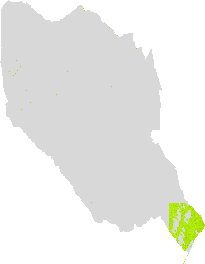Keyword
Cloud Cover: 96%
58 record(s)
Type of resources
Available actions
Topics
Keywords
Contact for the resource
Provided by
Years
Formats
Representation types
Update frequencies
Status
-

The Normalized Difference Vegetation Index (NDVI) is a measure of the amount and vigor of vegetation on the land surface and NDVI spatial composite images are developed to more easily distinguish green vegetation from bare soils. In general NDVI values range from -1.0 to 1.0 with negative values indicating clouds and water positive values near zero indicating bare soil and higher positive values of NDVI ranging from sparse vegetation (0.1 - 0.5) to dense green vegetation (0.6 and above).
-

Colour Index: The Colour Index algorithm was developed to differentiate soils in the field. Low valued CIs have been shown to be correlated with the presence of a high concentration of carbonates or sulfates and higher values to be correlated with crusted soils and sands in arid regions (Escadfal 1989). In most cases the CI gives complementary information with the BI and the NDVI. Used for diachronic analyses they help for a better understanding of the evolution of soil surfaces. The CI results from the following equation: CI = (red_factor * red - green_factor * green) / (red_factor * red + green_factor * green)
-

Cover fraction: FVC is used to separate vegetation and soil in energy balance processes including temperature and evapotranspiration. It is computed from the leaf area index and other canopy structural variables and does not depend on variables such as the geometry of illumination as compared to FAPAR
-

Canopy water content (CWC) the amount of water stored in the vegetation canopy is typically determined by multiplying the leaf water content by the canopy leaf area index (LAI). This calculation incorporates information about the leaf water condition and the canopy structure [1]. CWC is a critical parameter for assessing vegetation growth and monitoring drought stress. It is influenced by soil water supply and atmospheric demand.
-

Crop Early Warning Index: provides four alert levels based on the combination of VCI (Vegetation Condition Index) TAI (Temperature Anomaly Index) and PrI (Precipitation Index) anomalies. In particular: CREW = 1 if only VCI anomaly is present. CREW = 2 if VCI and TAI anomalies are present. CREW = 3 if VCI and PrI anomalies are present. CREW = 4 if VCI TAI and PrI anomalies are present.
-

The Normalized Difference Water Index algorithm was developed by Gao (19964) being a measure of liquid water molecules in vegetation canopies that interacted with the incoming solar radiation. NDWI is sensitive to changes in liquid water content of vegetation canopies. It is less sensitive to atmospheric effects than NDVI. NDWI does not remove completely the background soil reflectance effects therefore it should be considered as an independent vegetation index. It is complementary to not a substitute for NDVI. The NDWI results from the following equation: NDWI = (IR_factor * near_IR - mir_factor * middle_IR) / (IR_factor * near_IR + mir_factor * middle_IR)
-

The Weighted Difference Vegetation Index algorithm was introduced by Clevers (1988). This has a relationship to PVI similar to the relationship IPVI has to NDVI. WDVI is a mathematically simpler version of PVI but it has an unrestricted range.Like PVI WDVI is very sensitive to atmospheric variations (Qi et al. 1994). The WDVI results from the following equation: WDVI = (IR_factor * near_IR - g * red_factor * red) where: g is the slope of the soil line.
-

The Normalized Difference Water Index algorithm was developed by Gao (19964) being a measure of liquid water molecules in vegetation canopies that interacted with the incoming solar radiation. NDWI is sensitive to changes in liquid water content of vegetation canopies. It is less sensitive to atmospheric effects than NDVI. NDWI does not remove completely the background soil reflectance effects therefore it should be considered as an independent vegetation index. It is complementary to not a substitute for NDVI. The NDWI results from the following equation: NDWI = (IR_factor * near_IR - mir_factor * middle_IR) / (IR_factor * near_IR + mir_factor * middle_IR)
-

The Normalized Difference Pond Index algorithm was developed by J.P Lacaux et al. (2006).The NDPI makes it possible not only to distinguish small ponds and water bodies (down to 0.01 ha) but also to differentiate vegetation inside ponds from that in their surroundings The NDPI results from the following equation: NDPI = (mir_factor * middle_IR - green_factor * green) / (mir_factor * middle_IR + green_factor * green)
-

The Weighted Difference Vegetation Index algorithm was introduced by Clevers (1988). This has a relationship to PVI similar to the relationship IPVI has to NDVI. WDVI is a mathematically simpler version of PVI but it has an unrestricted range.Like PVI WDVI is very sensitive to atmospheric variations (Qi et al. 1994). The WDVI results from the following equation: WDVI = (IR_factor * near_IR - g * red_factor * red) where: g is the slope of the soil line.
